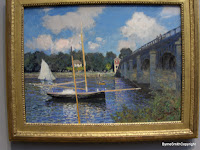 |
| Monet's The Bridge at Argenteuil at the National Gallery of Art Washington, D.C. |
Well, I finally finished it! I admit I'm not the fastest reader, but this one took me a while. It's not that it wasn't interesting. On the contrary, it's the most interesting and complete book about an artist, any artist, that I've ever read.
In my defense, it was a very long book to get through even with all those beautiful photos of his paintings and the interesting personal photos. It's a large format, coffee table book, so the text on each page is equal to at least two (maybe three) pages of a regular size book.
Did I mention it is 480 pages long?
Anyway, it was well worth however long it took me to read it. As you know, I'm a big Monet fan, so almost every chapter and page was full of information on him, his work, his career, and his family, most of which was new news to me and very interesting.
From his boyhood in Le Havre to his death at Giverny and everything that happened in between is covered. And that was a lot--he died in 1926 at the age of 86. There are all kinds of accounts of his artistic beginnings to the siege of Paris to the Impressionist era and beyond. So much information is included about the other Impressionists and his dealings with Durand-Ruel as well as his family life with Camille and children and then with the Hoschedes.
If you are a Monet fan, then it's a must-read, and it will keep you reading, even if it takes a long time to finish.
(BTW, my next book is Great British Watercolors from the Paul Mellon Collection by Matthew Hargraves.)
Happy Painting!
